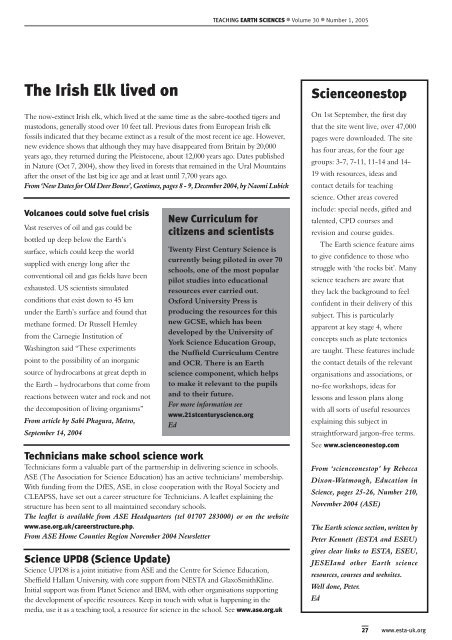teaching - Earth Science Teachers' Association
teaching - Earth Science Teachers' Association
teaching - Earth Science Teachers' Association
- No tags were found...
Create successful ePaper yourself
Turn your PDF publications into a flip-book with our unique Google optimized e-Paper software.
TEACHING EARTH SCIENCES ● Volume 30 ● Number 1, 2005<br />
The Irish Elk lived on<br />
The now-extinct Irish elk, which lived at the same time as the sabre-toothed tigers and<br />
mastodons, generally stood over 10 feet tall. Previous dates from European Irish elk<br />
fossils indicated that they became extinct as a result of the most recent ice age. However,<br />
new evidence shows that although they may have disappeared from Britain by 20,000<br />
years ago, they returned during the Pleistocene, about 12,000 years ago. Dates published<br />
in Nature (Oct 7, 2004), show they lived in forests that remained in the Ural Mountains<br />
after the onset of the last big ice age and at least until 7,700 years ago.<br />
From ‘New Dates for Old Deer Bones’, Geotimes, pages 8 - 9, December 2004, by Naomi Lubick<br />
Volcanoes could solve fuel crisis<br />
Vast reserves of oil and gas could be<br />
bottled up deep below the <strong>Earth</strong>’s<br />
surface, which could keep the world<br />
supplied with energy long after the<br />
conventional oil and gas fields have been<br />
exhausted. US scientists simulated<br />
conditions that exist down to 45 km<br />
under the <strong>Earth</strong>’s surface and found that<br />
methane formed. Dr Russell Hemley<br />
from the Carnegie Institution of<br />
Washington said “These experiments<br />
point to the possibility of an inorganic<br />
source of hydrocarbons at great depth in<br />
the <strong>Earth</strong> – hydrocarbons that come from<br />
reactions between water and rock and not<br />
the decomposition of living organisms”<br />
From article by Sabi Phagura, Metro,<br />
September 14, 2004<br />
New Curriculum for<br />
citizens and scientists<br />
Twenty First Century <strong>Science</strong> is<br />
currently being piloted in over 70<br />
schools, one of the most popular<br />
pilot studies into educational<br />
resources ever carried out.<br />
Oxford University Press is<br />
producing the resources for this<br />
new GCSE, which has been<br />
developed by the University of<br />
York <strong>Science</strong> Education Group,<br />
the Nuffield Curriculum Centre<br />
and OCR. There is an <strong>Earth</strong><br />
science component, which helps<br />
to make it relevant to the pupils<br />
and to their future.<br />
For more information see<br />
www.21stcenturyscience.org<br />
Ed<br />
Technicians make school science work<br />
Technicians form a valuable part of the partnership in delivering science in schools.<br />
ASE (The <strong>Association</strong> for <strong>Science</strong> Education) has an active technicians’ membership.<br />
With funding from the DfES, ASE, in close cooperation with the Royal Society and<br />
CLEAPSS, have set out a career structure for Technicians. A leaflet explaining the<br />
structure has been sent to all maintained secondary schools.<br />
The leaflet is available from ASE Headquarters (tel 01707 283000) or on the website<br />
www.ase.org.uk/careerstructure.php.<br />
From ASE Home Counties Region November 2004 Newsletter<br />
<strong>Science</strong> UPD8 (<strong>Science</strong> Update)<br />
<strong>Science</strong> UPD8 is a joint initiative from ASE and the Centre for <strong>Science</strong> Education,<br />
Sheffield Hallam University, with core support from NESTA and GlaxoSmithKline.<br />
Initial support was from Planet <strong>Science</strong> and IBM, with other organisations supporting<br />
the development of specific resources. Keep in touch with what is happening in the<br />
media, use it as a <strong>teaching</strong> tool, a resource for science in the school. See www.ase.org.uk<br />
<strong>Science</strong>onestop<br />
On 1st September, the first day<br />
that the site went live, over 47,000<br />
pages were downloaded. The site<br />
has four areas, for the four age<br />
groups: 3-7, 7-11, 11-14 and 14-<br />
19 with resources, ideas and<br />
contact details for <strong>teaching</strong><br />
science. Other areas covered<br />
include: special needs, gifted and<br />
talented, CPD courses and<br />
revision and course guides.<br />
The <strong>Earth</strong> science feature aims<br />
to give confidence to those who<br />
struggle with ‘the rocks bit’. Many<br />
science teachers are aware that<br />
they lack the background to feel<br />
confident in their delivery of this<br />
subject. This is particularly<br />
apparent at key stage 4, where<br />
concepts such as plate tectonics<br />
are taught. These features include<br />
the contact details of the relevant<br />
organisations and associations, or<br />
no-fee workshops, ideas for<br />
lessons and lesson plans along<br />
with all sorts of useful resources<br />
explaining this subject in<br />
straightforward jargon-free terms.<br />
See www.scienceonestop.com<br />
From ‘scienceonestop’ by Rebecca<br />
Dixon-Watmough, Education in<br />
<strong>Science</strong>, pages 25-26, Number 210,<br />
November 2004 (ASE)<br />
The <strong>Earth</strong> science section, written by<br />
Peter Kennett (ESTA and ESEU)<br />
gives clear links to ESTA, ESEU,<br />
JESEIand other <strong>Earth</strong> science<br />
resources, courses and websites.<br />
Well done, Peter.<br />
Ed<br />
27 www.esta-uk.org
















